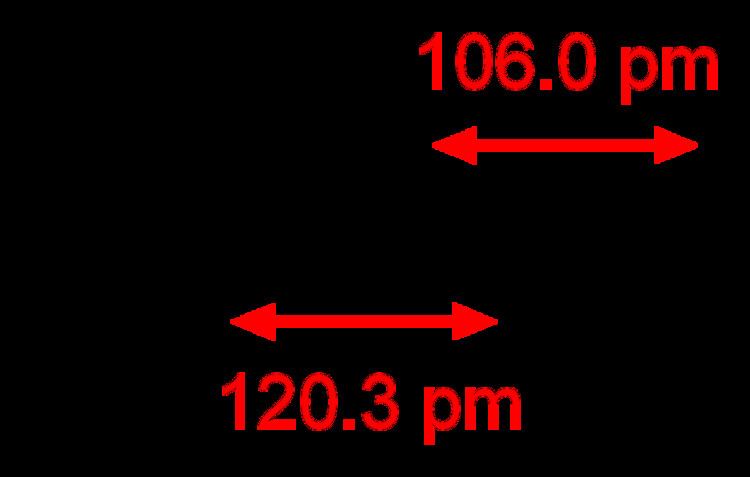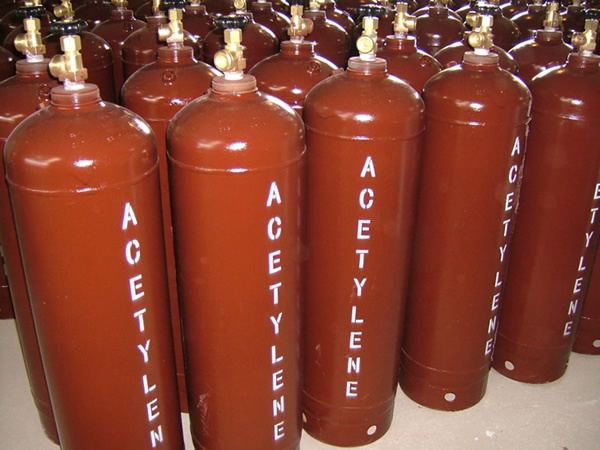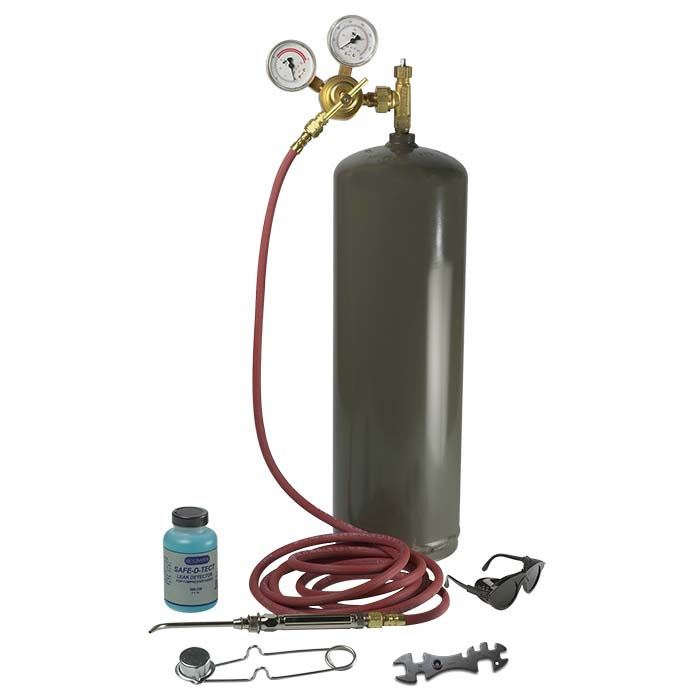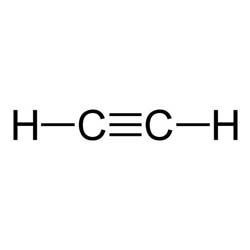Appearance Colorless gas IUPAC ID Ethyne Boiling point -84 °C Melting point -80.8 °C | Formula C2H2 Molar mass 26.04 g/mol Density 1.1 kg/m³ Classification Alkyne | |
 | ||
Acetylene (systematic name: ethyne) is the chemical compound with the formula C2H2. It is a hydrocarbon and the simplest alkyne. This colorless gas is widely used as a fuel and a chemical building block. It is unstable in its pure form and thus is usually handled as a solution. Pure acetylene is odorless, but commercial grades usually have a marked odor due to impurities.
Contents
- Acetylene
- Discovery
- Preparation
- Bonding
- Changes of state
- Other
- Metal acetylides
- Reppe chemistry
- Welding
- Portable lighting
- Plastics and acrylic acid derivatives
- Niche applications
- Natural occurrence
- Safety and handling
- References

As an alkyne, acetylene is unsaturated because its two carbon atoms are bonded together in a triple bond. The carbon–carbon triple bond places all four atoms in the same straight line, with CCH bond angles of 180°.

Acetylene
Discovery

Acetylene was discovered in 1836 by Edmund Davy, who identified it as a "new carburet of hydrogen". It was rediscovered in 1860 by French chemist Marcellin Berthelot, who coined the name "acétylène". Berthelot's empirical formula for acetylene (C4H2), as well as the alternative name "quadricarbure d'hydrogène" (hydrogen quadricarbide) were incorrect because chemists at that time used the wrong atomic mass for carbon (6 instead of 12). Berthelot was able to prepare this gas by passing vapours of organic compounds (methanol, ethanol, etc.) through a red-hot tube and collecting the effluent. He also found acetylene was formed by sparking electricity through mixed cyanogen and hydrogen gases. Berthelot later obtained acetylene directly by passing hydrogen between the poles of a carbon arc. Commercially available acetylene gas could smell foul due to the common impurities hydrogen sulfide and phosphine. However, as purity increases it will become odourless.
Preparation

Since the 1950s, acetylene has mainly been manufactured by the partial combustion of methane or appears as a side product in the ethylene stream from cracking of hydrocarbons. Approximately 400,000 tonnes were produced by this method in 1983. Its presence in ethylene is usually undesirable because of its explosive character and its ability to poison Ziegler-Natta catalysts. It is selectively hydrogenated into ethylene, usually using Pd–Ag catalysts.

Until the 1950s, when oil supplanted coal as the chief source of reduced carbon, acetylene (and the aromatic fraction from coal tar) was the main source of organic chemicals in the chemical industry. It was prepared by the hydrolysis of calcium carbide, a reaction discovered by Friedrich Wöhler in 1862 and still familiar to students:
CaC2 + 2H2O → Ca(OH)2 + C2H2
Calcium carbide production requires extremely high temperatures, ~2000 °C, necessitating the use of an electric arc furnace. In the US, this process was an important part of the late-19th century revolution in chemistry enabled by the massive hydroelectric power project at Niagara Falls.
Bonding
In terms of valence bond theory, in each carbon atom the 2s orbital hybridizes with one 2p orbital thus forming an sp hybrid. The other two 2p orbitals remain unhybridized. The two ends of the two sp hybrid orbital overlap to form a strong σ valence bond between the carbons, while on each of the other two ends hydrogen atoms attach also by σ bonds. The two unchanged 2p orbitals form a pair of weaker π bonds.
Since acetylene is a linear symmetrical molecule, it possesses the D∞h point group.
Changes of state
At atmospheric pressure, acetylene cannot exist as a liquid and does not have a melting point. The triple point on the phase diagram corresponds to the melting point (−80.8 °C) at the minimum pressure at which liquid acetylene can exist (1.27 atm). At temperatures below the triple point, solid acetylene can change directly to the vapour (gas) by sublimation. The sublimation point at atmospheric pressure is −84.0°C.
Other
The adiabatic flame temperature in air at atmospheric pressure is 2534 °C.
Acetylene gas can be dissolved in acetone or dimethylformamide in room temperature and 1 atm.
Metal acetylides
Since acetylene has a pKa of 25, acetylene can be deprotonated by a superbase to form an acetylide:
HC≡CH + RM → RH + HC≡CMVarious organometallic and inorganic reagents are effective. The formation of the acetylide depends upon several factors such as the pKb of the base, the valency of the metal, and solvent characteristics.
Copper(I) acetylide and silver acetylide can be formed in aqueous solutions with especial ease due to a poor solubility equilibrium.
Reppe chemistry
Walter Reppe discovered that in the presence of metal catalysts, acetylene can react to give a wide range of industrially significant chemicals.
Welding
Approximately 20 percent of acetylene is supplied by the industrial gases industry for oxyacetylene gas welding and cutting due to the high temperature of the flame; combustion of acetylene with oxygen produces a flame of over 3,600 K (3,330 °C; 6,020 °F), releasing 11.8 kJ/g. Oxyacetylene is the hottest burning common fuel gas. Acetylene is the third-hottest natural chemical flame after dicyanoacetylene's 5,260 K (4,990 °C; 9,010 °F) and cyanogen at 4,798 K (4,525 °C; 8,177 °F). Oxy-acetylene welding was a very popular welding process in previous decades; however, the development and advantages of arc-based welding processes have made oxy-fuel welding nearly extinct for many applications. Acetylene usage for welding has dropped significantly. On the other hand, oxy-acetylene welding equipment is quite versatile – not only because the torch is preferred for some sorts of iron or steel welding (as in certain artistic applications), but also because it lends itself easily to brazing, braze-welding, metal heating (for annealing or tempering, bending or forming), the loosening of corroded nuts and bolts, and other applications. Bell Canada cable repair technicians still use portable acetylene fuelled torch kits as a soldering tool for sealing lead sleeve splices in manholes and in some aerial locations. Oxyacetylene welding may also be used in areas where electricity is not readily accessible. As well, oxy-fuel cutting is still very popular and oxy-acetylene cutting is utilized in nearly every metal fabrication shop. For use in welding and cutting, the working pressures must be controlled by a regulator, since above 15 psi, if subjected to a shockwave (caused for example by a flashback), acetylene will decompose explosively into hydrogen and carbon.
Portable lighting
Calcium carbide was used to generate acetylene used in the lamps for portable or remote applications. It was used for miners and cavers before the widespread use of incandescent lighting; or many years later low-power/high-lumen LED lighting; and is still used by mining industries in some nations without workplace safety laws. It was also used as an early light source for lighthouses.
Plastics and acrylic acid derivatives
Acetylene can be partially hydrogenated to ethylene, providing a feedstock for a variety of polyethylene plastics. Another major application of acetylene is its conversion to acrylic acid derivatives. These derivatives form products such as acrylic fibers, glasses, paints, resins, and polymers.
Niche applications
In 1881, the Russian chemist Mikhail Kucherov described the hydration of acetylene to acetaldehyde using catalysts such as mercury(II) bromide. Before the advent of the Wacker process, this reaction was conducted on an industrial scale.
The polymerization of acetylene with Ziegler-Natta catalysts produces polyacetylene films. Polyacetylene, a chain of CH centres with alternating single and double bonds, was one of the first discovered organic semiconductors. Its reaction with iodine produces a highly electrically conducting material. Although such materials are not useful, these discoveries led to the developments of organic semiconductors, as recognized by the Nobel Prize in Chemistry in 2000 to Alan J. Heeger, Alan G MacDiarmid, and Hideki Shirakawa.
In the early 20th century acetylene was widely used for illumination, including street lighting in some towns. Most early automobiles used carbide lamps before the adoption of electric headlights.
Acetylene is sometimes used for carburization (that is, hardening) of steel when the object is too large to fit into a furnace.
Acetylene is used to volatilize carbon in radiocarbon dating. The carbonaceous material in an archeological sample is treated with lithium metal in a small specialized research furnace to form lithium carbide (also known as lithium acetylide). The carbide can then be reacted with water, as usual, to form acetylene gas to be fed into mass spectrometer to measure the isotopic ratio of carbon-14 to carbon-12.
Natural occurrence
The energy richness of the C≡C triple bond and the rather high solubility of acetylene in water make it a suitable substrate for bacteria, provided an adequate source is available. A number of bacteria living on acetylene have been identified. The enzyme acetylene hydratase catalyzes the hydration of acetylene to give acetaldehyde.
C2H2 + H2O → CH3CHOAcetylene is a moderately common chemical in the universe, often associated with the atmospheres of gas giants. One curious discovery of acetylene is on Enceladus, a moon of Saturn. Natural acetylene is believed to form from catalytic decomposition of long-chain hydrocarbons at temperatures of 1,700 K (1,430 °C; 2,600 °F) and above. Since such temperatures are highly unlikely on such a small distant body, this discovery is potentially suggestive of catalytic reactions within that moon, making it a promising site to search for prebiotic chemistry.
Safety and handling
Acetylene is not especially toxic but, when generated from calcium carbide, it can contain toxic impurities such as traces of phosphine and arsine, which give it a distinct garlic-like smell. It is also highly flammable, as most light hydrocarbons, hence its use in welding. Its most singular hazard is associated with its intrinsic instability, especially when it is pressurized: under certain conditions acetylene can react in an exothermic addition-type reaction to form a number of products, typically benzene and/or vinylacetylene, possibly in addition to carbon and hydrogen. Consequently, acetylene, if initiated by intense heat or a shockwave, can decompose explosively if the absolute pressure of the gas exceeds about 200 kilopascals (29 psi). Most regulators and pressure gauges on equipment report gauge pressure and the safe limit for acetylene therefore is 101 kPagage or 15 psig. It is therefore supplied and stored dissolved in acetone or dimethylformamide (DMF), contained in a gas cylinder with a porous filling (Agamassan), which renders it safe to transport and use, given proper handling. Acetylene cylinders should be used in the upright position to avoid withdrawing acetone during use.
Information on safe storage of acetylene in upright cylinders is provided by the OSHA, Compressed Gas Association, United States Mine Safety and Health Administration (MSHA), EIGA, and other agencies.
Copper catalyses the decomposition of acetylene and as a result acetylene should not be transported in copper pipes. Brass pipe fittings should also be avoided.
Cylinders should be stored in an area segregated from oxidizers to avoid exacerbated reaction in case of fire/leakage. Acetylene cylinders should not be stored in confined spaces / enclosed vehicles / garages / buildings to avoid unintended leakage leading to explosive atmosphere. In the USA, National Electric Code (NEC) requires consideration for hazardous areas including those where acetylene may be released during accidents or leaks. Consideration may include electrical classification and use of listed Group A electrical components in USA. Further information on determining the areas requiring special consideration is in NFPA 497. In Europe, ATEX also requires consideration for hazardous areas where flammable gases may be released during accidents or leaks.
